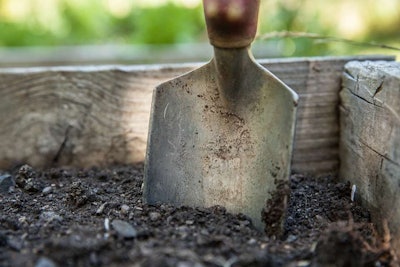
Urban soil can also become degraded from pollution, disturbance or compaction, which in turn reduces the amount of oxygen reaching plants’ root systems. Overusing soil year after year can leave pH, mineral and microbe levels off balance so it is your job to restore the soil to its fertile state.
Ideal soil should be loose, deep and crumbly but this is not a guarantee that it has the needed nutrients, so it is important to conduct a soil test before trying to correct any deficiencies.
Plants need 17 essential nutrients and 14 of them must come from the soil. The three macronutrients – nitrogen, phosphorous and potassium – are the most needed ones and these are the nutrients you’ll commonly see mentioned on fertilizers.
If plants aren’t growing properly, applying fertilizers incorrectly can sometimes exacerbate the problem, for example excess nitrogen can often increase insect and disease infestations.
When it comes to fertilizers, you can choose from natural fertilizers, also called organic, and synthetic fertilizers.
Natural fertilizers like compost help improve the soil structure, water- and nutrient-holding capacity and living organism presence when worked into the existing soil. They release nutrients at a slower rate and over a longer period of time than synthetic fertilizers and should be applied at a low application rate to avoid oversupplying nutrients, as over-application can damage plants.
Synthetic fertilizers are cheaper than natural fertilizers and are more rapidly available because they are more water-soluble or in a form plants can use. One disadvantage is that it is easier to over-apply synthetic fertilizers, causing fertilizer burn, and they do not support beneficial microbial populations to the same extent as natural fertilizer.
Even when a fertilizer is applied at the proper rate and time, there are several factors that affect the plant’s ability to use nutrients.
The amount of water can either leach nutrients from the soil when there is too much or prevent the nutrients from dissolving and entering the plant when there is too little water. Other unfavorable growing conditions such as drought, insufficient sunlight or compacted soil will hurt the plant’s ability to absorb the nutrients.
If the soil pH is very acidic or very basic, many nutrients will become inaccessible as pH affects how tightly nutrients are bound to soil particles. The overabundance of one nutrient can also affect the availability of other nutrients.
As the North Carolina State University Cooperative Extension explains it, the soil acts as a bank for most plant nutrients.
“Withdrawals are made from the soil solution, much as you would with draw money from a checking account,” the extension says. “The undissolved pool of soil nutrients is like a savings account. When checking funds are low, transfers are made from the savings account to the checking account. In the same way, for many plant nutrients, when the soil solution has excess nutrients, some bind to the soil to become temporarily unavailable, and some react with other chemical elements to form insoluble minerals, which can dissolve again later.”









